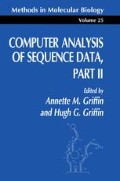Abstract
A “sequence format” is a punctuation style, or defined layout of text, within a computer file that separates a sequence from everything else. It allows computer programs that “understand” the format to distinguish between the sequence and any reference documentation also in the file. Some format definitions extend to the documentation itself (i.e., most database formats), allowing some software to locate specific reference information (e.g., authors, journals, species classification, coding regions).
Access this chapter
Tax calculation will be finalised at checkout
Purchases are for personal use only
References
Stoehr, P J and Cameron, G. N (1991) The EMBL data library. Nucleic Acids Res. 19, 2227–2230.
Burks, C, Cassidy, M, Cinkosky, M. J, Cumella, K. E., Gilna, P., Hayden, J E-D., Keen, G. M, Kelley, T A., Kelly, M., Kristofferson, D., and Ryals J. (1991) GenBank Nucleic Acids Res. 19, 2221–2225
Devereux, J, Haeberh, P., and Smithies, O (1984) A comprehensive set of sequence analysis programs for the VAX. Nucleic Acids Res. 12, 387–395
Orcutt, B. C, George, D. G, Fredrickson, J. A, and Dayhoff, M. O. (1982) Nucleic acid sequence database computer system Nucleic Acids Res 10, 157–174
Orcutt, B. C, George, D. G., and Dayhoff, M. O (1983) Protein and nucleic acid sequence database computer systems. Ann. Rev. Biophys. Bioeng 12, 419–441.
Hunt, L. T. (1990) in Protein Identification Resource Newsletter, vol 9, May. National Biomedical Research Foundation, Washington, DC
Pearson, W. R. and Lipman, D. J. (1988) Improved tools for biological sequence comparison. Proc Natl. Acad. Sci. USA 85, 2444–2448.
Staden, R. (1986) The current status and portability of our sequence handling software. Nucleic Acids Res. 14(1)
Barker, W. C, George, D. G., Hunt, L. T., and Garavelli, J. S. (1991) The PIR protein sequence database. Nucleic Acids Res 19, 2231–2236
Bairoch, A. and Boeckmann B. (1991) The SWISS-PROT protein sequence data bank. Nucleic Acids Res. 19, 2247–2249
Author information
Authors and Affiliations
Rights and permissions
Copyright information
© 1994 Human Press Inc, Totowa, NJ
About this protocol
Cite this protocol
O’Donnell, C. (1994). Converting Between Sequence Formats. In: Computer Analysis of Sequence Data. Methods in Molecular Biology, vol 25. Springer, Totowa, NJ. https://doi.org/10.1385/0-89603-276-0:391
Download citation
DOI: https://doi.org/10.1385/0-89603-276-0:391
Publisher Name: Springer, Totowa, NJ
Print ISBN: 978-0-89603-276-7
Online ISBN: 978-1-59259-512-9
eBook Packages: Springer Protocols

